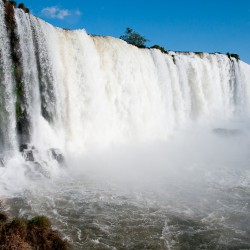When to go to Iguassu Falls

Iguassu Falls is the international name for the locally known Iguaçu Falls just outside of Foz do Iguaçu, Brazil. Iguassu Falls is located on the border of Brazil and Argentina. There are 275 different falls that make up the Iguassu Falls system.
The falls can be experienced from either the Argentinean or Brazilian side. Because the experiences are so different, it is easy to argue which side provides the best experience. Ideally you will have the time to explore the falls from both sides of the most comprehensive experience possible.
In this article we are looking at the best times to explore the Brazilian side of Iguassu Falls. if you are looking for more information about the Argentinean side of the falls, please explore the When To Go to Iguazu Falls article.
When to go to Iguassu Falls
The best time to go to Iguassu Falls depends on your primary interests. Some prefer to go when the water is at its highest, whereas others prefer to go when they have more access to the activities and parts of the park.
I believe the best time to visit the falls is when the weather is expected to be better even though the falls are not at their peak levels. I find that the falls are more aesthetically pleasing with rocks breaking through the water, particularly when there are bright blue skies in the background. This also makes for the better photography. These months would include March, parts of April, and August and September.
When to go to Iguassu Falls: Weather
Iguassu Falls is mostly a tropical area providing fairly accessible whether year-round. Instead of summer, winter and fall thinking, most people talk about the rainy season versus the dry season when it comes to exploring Iguassu Falls.
The heaviest rains occur during the months of December through February. This makes the water levels higher in the falls stronger with more volume of water. For some this is the most impressive time to come. However the higher water levels will keep you away from San Martin Island, and you may find other trails closed because of water damage. Another drawback is there is a greater chance for gray or cloudy skies.The higher water levels also create more missed making it challenging to see parts of the falls.
The summer months of December through March represent the warmest time of the year. Because of the higher temperatures and all the water, the humidity can be really high. Temperatures range from about 73°F in the evening to 90°F during the day. If you’re taking one of the boat rides into the falls, these warmer temperatures can make getting wet more enjoyable. This is a fun activity and a great way to experience the falls so this is something to consider. The dry season runs from April and into June. The good news with this time of year is that the skies are usually blue. The potential drawback is lower water levels and less than impressive falls.
The months from June through August are cooler with the temperatures ranging from 50°F in the evening to 73°F during the day. The good news is that the humidity is quite less. Although the rain is heavier during the months of December through February, these months expect rain as well.
The best time to visit Iguassu Falls based on weather is it probably during March, parts of April, August, and September. However, it is important to note that this is a tropical destination and it can rain any time of the day or year.
When to go to Iguassu Falls: Holidays
The months of January and February represent the period when many Argentineans and Brazilians take vacations. This adds to an influx of locals visiting the falls and creating more crowds and higher rates. Another popular time for locals to visit the falls occurs during the week of Easter. This again, is a crowded time for visiting the falls with continued higher rates.
When to go to Iguassu Falls: Time of day
The Brazilian side of Iguassu Falls can be experienced in half a day. However the best time to visit the Brazilian side of the falls varies depending on which part of the falls you are viewing. Most panoramic view of the falls occur from the Brazilian side but is primarily looking out across the river towards the Argentinean side of the falls. The best time of day to experience these views is during the early morning hours. The sun will be behind you and be lighting up the falls across the way.
However, as you get closer to the Devils Throat part of the falls and the actual Brazilian side of the falls, you will find yourself looking into the sun if it is during the morning hours. The best time of day to visit this part of the falls is in the latter afternoon hours. Here the sun will be shining from the Argentinian side back towards the Brazilian side of the falls. This makes for easier viewing and better photography.
Ideally, you will explore the Brazilian side of the falls at 2 different times of the day for the best viewing and photographic opportunities. When you witness how impressive these falls are and you want to capture them with your camera, this becomes a very important factor.
